ORIGINAL ARTICLE
SILVA, Pedro Antonio da [1]
SILVA, Pedro Antonio da. Blockchain for logistic and supply chain for animal protein and genetic improvement: a systematic literature review. Revista Científica Multidisciplinar Núcleo do Conhecimento. Year 08, Ed. 03, Vol. 01, pp. 05-45. March 2022. ISSN:2448-0959, Access link in: https://www.nucleodoconhecimento.com.br/business-administration/blockchain-for-logistic, DOI: 10.32749/nucleodoconhecimento.com.br/business-administration/blockchain-for-logistic
ABSTRACT
Context: the emergence of TB (Blockchain Technology), interesting gains for the economy, helping companies, governments and customers with integration and reliability of information without intermediaries. Objective: Through a systematic literature review analyzing the use of applied TB in the areas of logistics and Supply Chain (SC) to first verify the benefits of using applied TB, as well as the study of the main areas of TB use, classifying in articles from searched databases which are the main relevant areas for the application of TB due to the number of articles found and the quality of the studies generated. Second, analysis of the impacts of this technology on the corporate environment, generating solutions that help in the operational part and in the resolution of communication with partners. Third, how can TB help companies to have a sustainable SC without natural impacts, food contamination problems and where everyone in SC has a healthy business without interference from agents that do not add value to the production chain. Fourth, to analyze how TB can help in the process of genetic improvement from animal protein SCs. Challenges: Challenges posed to global TB and SCs. Method: the systematic literature review (SLR) among articles from 2017 to 2020. Result: the results of the systematic literature review indicate that some of the main benefits are the traceability and reliability generated by the use of TB in logistics and CS, among the impacts raised 62% were classified as positive and aggregators for the use of TB in SCs, when it comes to having efficient socio-environmental SCs, TB can maximize the transparency of manufacturing processes and agricultural production without the use of harmful toxins and genetic improvement. Perspectives: what is expected from the use of TB in supply chains and integration with other 4.0 technologies.
Keywords: Biosensor, Genetic engineer, Hyperledger, Sawtooth.
1. INTRODUCTION
Blockchain’s basic idea is to be a collaborative medium for recording secure information among network participants, in a public, auditable way that helps to provide verification and authenticity for the records. Whenever a transaction is initiated, a group of voluntary registrations will be made on the network in their respective copies of shared registries (CUI et al., 2019a).
The blockchain technology was commented initially by Satoshi Nakamoto in a paper: a peer-to-peer electronic cash system, that defines the blockchain technology as a distributed ledger information (NAKAMOTO, 2008). The blockchain technology can facilitate the exchange and sharing information among network users without the need of middlemen and others acting as arbitrators.
Blockchain technology has emerged as a technology layer for financial applications and in recent years it has had the attention of researchers and developers for its application in other domains. Due to its immutability and public accessibility without the need for intermediaries, blockchain can increase efficiency, reliability and transparency throughout the logistics and SC, thus optimizing the entry and exit processes (PERBOLI; MUSSO and ROSANO, 2018).
In a traditional network, communication is validated by a third intermediary element to be considered as true information for the rest of the network, the same does not happen in a blockchain network, in which all records are shared between all network participants at the moment when two participants carry out the communication unilaterally. The difference between a centralized network structure and a blockchain network, in which it presents the characteristics of peer-to-peer transactions, that is, without the need for a central intermediary is shown in Figure 1.
Figure 1 – Traditional and blockchain networks
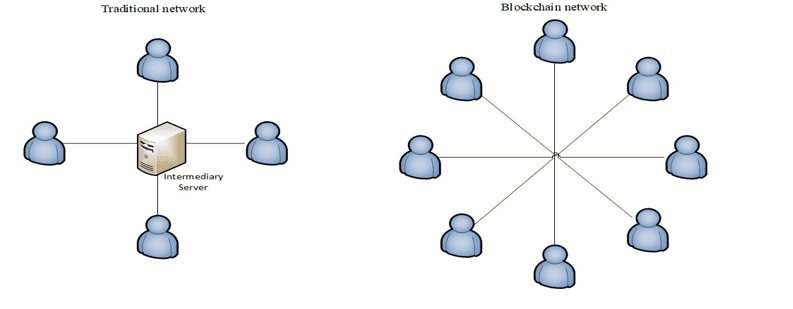
1.1 LOGISTIC AND SC
Nowadays, the areas of logistic and SC are getting more evidence and increasingly more complex, extended, and global. An event on one side of the world can stop the production or delivery of a service on the other side. The event may be a natural or man-made cause, that event can be small or large, however if the supply of a component or service disruptive, such consequences will be disastrous along the SC and its participating companies, both in terms of reputation and financially (BOSCHI et al., 2018). The main idea behind SC Management (SCM) is to manage the flow of products, services, and information in an effective way in order to achieve high performance and decrease risks involved in these movements.
Business logistics is a relatively new field in the study of integrated management, traditional areas of finance, marketing and manufacture. SCM is a more recent term that captures the essence of integrated logistics and even goes beyond it. SCM takes into account the logistical interactions that occur between marketing, logistics and production functions within a company, and those same interactions between companies legally separated within the product and raw material flow channel (BALLOU and SRIVASTAVA, 2007). The SC ecosystem describes the processes that involve the areas of design, engineering, manufacturing and distribution of products and services of suppliers, intermediaries and final consumers, such processes involve and affect the products through out the chain, information and finance, some regulations are confirmed to protect consumer rights.
The United Nations treats basic consumer rights as the right to safety, the right to be informed, the to redress and the right to a healthy environment (AZZI; CHAMOUN and SOKHN, 2019). The inventory management for logistics management is essential because it is impossible and impractical to produce something instantly and guarantee delivery times for your consumers. The inventories of a logistics chain act as an emergency reserve that allows to balance the demand generated by the market and its productive capacity, ensuring the availability of these products at its points of sale. At the same time, it allows the logistics chain manager to search for new efficient methods and technologies to improve the supply of their production and distribution of their products (BALLOU and SRIVASTAVA, 2007). The role of inventory management for logistics management is, according to Ballou and Srivastava (2007), to establish world-class logistics performance for large American companies when they have the characteristics mentioned below:
- Dispatch error index of less than one per million items shipped.
- Logistical cost less than 5 percent of the value of sales made.
- Have inventory turnover greater than 20 times a year.
- Do not exceed five working days of the total order cycle between your purchase by the customer and your delivery.
- Transport cost less than or equal to 1 percent of the sales revenue, when the products delivered cost more than 5 dollars, the calculation is based on the weight transported.
The systematic review study contemplated in this paper will answer the research questions mentioned in Figure 2:
Figure 2 – Research questions
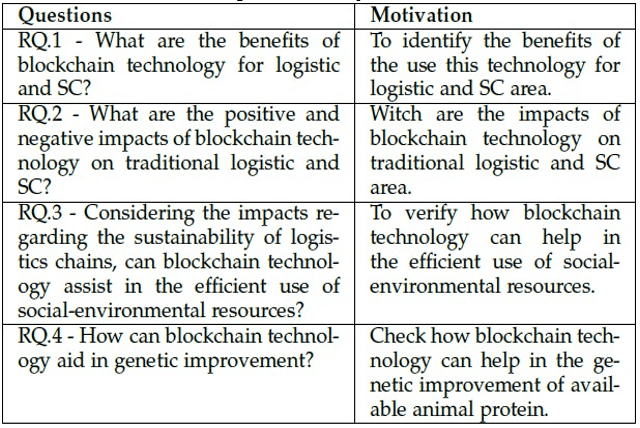
The following items explored by this paper are: (2) Background and Related Work – verification of the theoretical bases of applied technology and works similar to the paper; (3) Challenge definitions for blockchain technology and supply chain; (4) Research Methodology – deepening on the methodology used to carry out such a systematic review of the literature; (5) Results and Analysis – explanation of the results obtained and their analysis; (6) Prospects for using blockchain technology for supply chains; (7) Conclusion conclusive establishment on the scope of this research.
1.2 INTEGRATION BETWEEN TECHNOLOGIES
The integrated use of technologies can solve important problems for the genetic improvement of the herd, resulting in greater productivity of the producing farms, as well as the reliability and tracking of all supply chains involved in animal protein, according to Figure 3.
Figure 3 – Integration between technologies
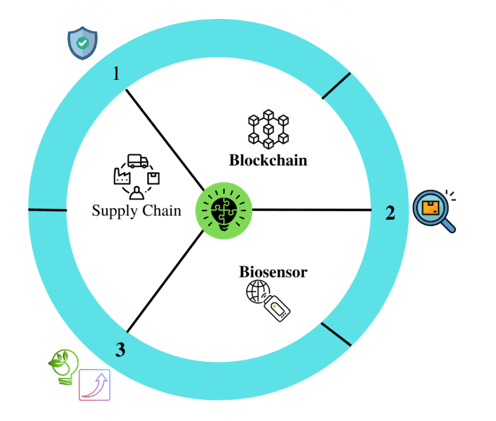
In Figure 3 we can see the integration between Biosensors and Blockchain technologies for the effective management of the animal protein supply chain, as well as highlighting important features for the members involved, such as:
- Reliability: Blockchain technology provides the supply chain with the reliability of information captured in all processes involved in food production.
- Traceability: Tracking through genetic markers of the herd is the safest way to capture information and brings the best added value to the producer due to the use of this information for the genetic improvement of the animal, correct management and better use of this resource by through the correct destination to the consumer market.
- 1. Environmental sustainability: The reduction of the productive cycle through the genetic improvement of the herd leads to the reduction of areas
for raising herds and the opening of new deforested areas destined for the extensive breeding culture
- 2. Increase in production and level of quality: Through the genetic improvement of the herd, it provides a proportional increase in the use of carcasses of animals destined for slaughter, improvement in milk production, leather quality and in the conversion of gain % of weight x feed supplied. This initiative also provides consumers with considerable gains in terms of the quality of these foods and financial gains for the producer due to products with different quality levels.
The use of Biosensors can facilitate the collection of genetic markers in the field in a simple and inexpensive way, thus forming a large genetic bank of several herds of specific breeds or mixed breeds. According to (COMIN et al., 2022), genetic associations are extremely important to determine commercial economic traits related to cattle production, including resistance to IBK. Hereford cattle are the most sensitive to IBK compared to other breeds such as Angus, Charolais or Red Poll. There are currently few studies in the literature that take into account the issue of Hereford heritability with respect to IBK resistance. Genetic phenotyping is often expensive and impractical given the need for disease outbreaks in herds to generate data to verify genetic traits that determine genetic factors of natural resistance in the herd.
Blockchain technology, in turn, will guarantee the transparency and reliability of the genetic information captured in the field by the biosensors, thus facilitating historical access to the characteristics of the phenotypes of a given breed and/or region. Usually food supply chains are characterized by their great complexity of service. The products that circulate in these supply chains are often dispersed in their respective production phases and among other vast hidden networks for suppliers and consumers, this situation raises the question of how to effectively manage food supply chains. These uncertainties raise various concerns about the management of food supply chains regarding food safety, issues of culling procedures due to religious restrictions and environmental sustainability due to production in deforested areas (REJEB, 2018).
The Supply Chain can take advantage of the benefits of both technologies to avoid possible interruptions in supplies or reliability problems for its final consumers. The most important characteristic for meat production is defined by its marbling, which gives juiciness, flavor and tenderness. This characteristic contributes directly to the price charged for beef in the national and international market. Some genes are candidates to be responsible for the marbling characteristic of beef cattle, such as diacylglycerol O-acyltransferase1 (DGAT1), thyroglobulin (TG), growth hormone (GH), leptin (LEP) and stearoylcoenzyme A desaturase (SCD) (RIPOLI et al., 2011). The use of Biosensors from the first moment of the production cycle can highlight such characteristics, helping supply chains to have better quality products and with a shorter production cycle, obtaining greater productivity per square meter.
2. BACKGROUND AND RELATED WORK
Blockchain technology has the potential to change global SCs, but it must overcome several obstacles that hinder the adoption of some generalities among the markets participating in SC. Because it is a relatively new technology, stakeholders in SC so far do not have clear information that allows the implementation of blockchain technology to analyze its consequences and the possible risks involved in its adoption. Such application of blockchain technology aims to facilitate the exchange of information between manufacturers, carriers and outsourced providers for logistic services (3PL) (HEWETT; LEHMACHER and WANG, 2019).
Azzi; Chamoun and Sokhn (2019) list some startups that offer blockchain technology as a traceability solution within SCs, logistics management of manufacturing units and distribution centers such as: Ambrosus, Ascribe, Blockverify, Chronicled, OwlChain, Provenance, Modum, Everledger, Verisart and TrustChain.
Baralla; Pinna and Corrias (2019) propose the implementation of a SC control system based on blockchain technology called AgriBlockIOT, his system works with both blockchain network solutions, this being the Ethereum and Hyperledger Sawtooth solution. In its empirical results, it shows that the Sawtooth solution performs better compared to the Ethereum solution in detecting a greater immaturity among such blockchain solutions.
Figure 4 shows an example of SC and its respective points of interaction with blockchain technology, ensuring product traceability from the point of origin to the final point of sale. Such information is aggregated throughout this process immutably, represented between (B1) and (B6), and with possible access to everyone involved in the process, in addition to giving the customer the opportunity to know the trajectory of the product they are purchasing. SC starts with the production of the basic raw material for the product and it can add process data and important material information added to the final product.
Figure 4 – Blockchain traceability in a SC
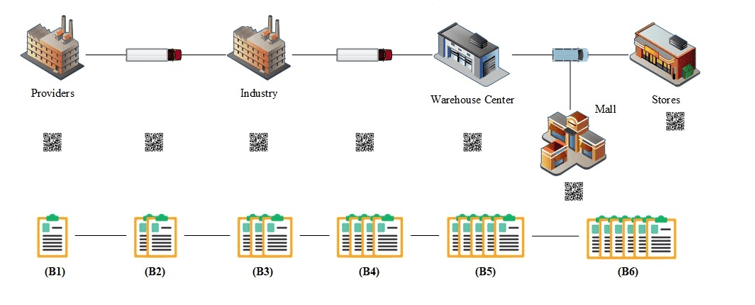
2.1 THE GROWING NEED FOR TRACEABILITY
In the food industry, the use of blockchain technology is being widely studied due to several incidents involving situations of bacterial contamination of food due to improper storage or transportation, use of toxic substances for pest control that may be associated with the appearance of cancerous diseases, as well as the increase in chemical additives banned by health organizations. Due to food security incidents, as well as crises, it not only initiated several actions to regulate food SCs, but also generated great awareness among its consumers. Nowadays, traced food is an aspect of great importance for consumers to have confidence in the safety and quality of the items consumed (BEHNKE and JANSSEN, 2020).
Safe production has been a topic of great interest to the food industry and in recent years many pesticides have been invented that are constantly used to repel crop pests. Much of the research is for certain types of crops and there is no general method to prevent crops from these pests and their possible damage, for example, in Pakistan alone the damage caused by pests is greater than thirty million dollars, being an amount similar to the damage caused by rodents.
Other efforts proposed by a solution used in blockchain technology for food security in food greenhouses, however such fees are applied or use IOT devices to maintain an immutable record, without qualifications a major problem of scalability and efficiency of the solution. There is no record of the use of blockchain technology and its benefits in the area of precision agriculture (IQBAL and BUTT, 2020).
Cui et al. (2019b) mentions that to guarantee the traceability of the device it is essential to provide the principle of trust between the different entities in electronic SC. The author proposes the use of blockchain technology in order to ensure the safety and integrity of electronic components, enabling the traceability of these items in SC. In the project proposed by the author, blockchain technology and smart contracts allow the traceability of items and the verification of their paths during their respective SCs, and the smart contract works as a computer protocol to facilitate verification and obtain the imposition of digitization of negotiating or executing a contract.
2.2 COSTS OF IMPLEMENTATION AND SCALABILITY
Storage capacity and scalability issues are items that profoundly affect the implementation of blockchain technology, the greater the number of nodes installed on the blockchain network increases the difficulty of obtaining processing speed of the information recorded and read in the blockchain structure as it is expected for the validation of this information on all blockchain nodes (ZHAO et al., 2019).
There are two types of blockchain technology, these being public and private. Private or corporate blockchain, that is, blockchain network structures, in which they are managed through a restricted group of users. Examples of this private blockchain network structure are the solutions: Quorum and Hyperledger Fabric, such structures bring with them a greater need for transaction per second, taking into account the configuration and systemic speed. The Hyperledger Fabric solution can perform 3,500 transactions per second. The public blockchain used with the Visa credit card payment processing solution performs an average of 2,000 transactions per second, such limitations create a gap in terms of scalability of blockchain technology (PERBOLI; MUSSO and ROSANO, 2018). Due to the nature of transactions involving companies and their respective confidentiality, private blockchain is necessary.
The costs of implementing blockchain technology are relatively high due to the great need for processing to have an active blockchain. Zhao et al. (2019) mentions that the different contributions offered by blockchain technology are among them the reduction of the costs of the transactions carried out, even if it implies such technology in a revealing amount of financial resources for its installation, making it difficult to implement this architecture in small and medium companies. Zhao et al. (2019) shows that participants in agrifood value chains need a lot of money and time to deploy blockchain technology in the current food product traceability network. It also notes that at the moment when the blockchain becomes bigger and more complex, it requires computational power to support such transit of information between network agents and validate the blocks, the same being taken into account for the consumption of electricity. Other studies indicate that public blockchain solution networks consume large amounts of energy after being subjected to labor tests, and this energy is consumed in two different ways: (1) used in the mining process, in which it involves consensus to search for the appropriate hash for the validation condition of the previous block; (2) another part of the energy is consumed by the point-to-point information transmission process, which requires energizing the edge device.
2.3 RELATED WORK
Related work is divided into related work on blockchain technology and work related to herd genetic engineering. In blockchain technology, initiatives with the use of blockchain for the traceability of products in their respective supply chains will be discussed. While, in the part of genetic engineering of herds, it will essentially be about biosensors, for the optimization of herds.
2.3.1 RELATED WORKS IN TECHNOLOGY BLOCKCHAIN
Currently, there are a large number of similar initiatives using blockchain technology for product traceability on their SCs. Zhang et al. (2020) mentions that Walmart in partnership with IBM has developed a system for managing pork SC based on the Hyperledger Fabric system. In this solution, only the primary traceability information and strategic points in the SC are stored on the blockchain, with large amounts of information at each SC crossing point being stored in databases that work together with the blockchain. In the blockchain network it is not convenient to store videos and photos, documents and other important information for the business, at this stage it is important to design the solution, in which the difficulties imposed by blockchain technology is not in any way an impediment to the implementation of the project between its SC partners improving the practical application of the project. Another example of application of blockchain technology is through regulatory agencies and governments, in which the need to record all commercial information in the SC can facilitate fiscal control and ensure the security of origin of products handled among SC agents.
Blockchain technology is generally linked to the use of other new technologies, such as artificial intelligence and remote sensing (IoT and RFID) for the collection and analysis of data obtained in the SC. In these sensing points, information such as location, time, temperature and humidity level report data to a blockchain (BUMBLAUSKAS et al., 2020). Baralla; Pinna and Corrias (2019), in their paper mention the creation of a blockchain solution for the SC called AgriBlockIoT based on Hyperledger Sawtooth technology for the control of origin and traceability of food produced in the European Union. This solution allows the simultaneous use of several companies and producers so the latency of the blockchain network is not the limitation of this solution.
2.3.2 WORKS RELATED TO THE GENETIC ENGINEERING OF HERDS
Historically, cattle were first introduced to the Western Hemisphere in 1493 and by subsequent introductions from the Iberian Peninsula, providing the genetic background for American Creole cattle, with influences from Spanish, Portuguese and African breeds. The high adaptive capacity of Creoles allowed them to spread and colonize a wide variety of environments. Their ancestry combined with local adaptations created the broad spectrum of American Creole breeds we see today, many currently endangered (ARMSTRONG et al., 2022). Armstrong et al. (2022) review existing genetic and production data on Argentine, Mexican, Uruguayan, and US Creole cattle that form the basis of their research. In such countries, Creole cattle became the basis of the livestock industry for the supply of meat, hides and animal labor, until they were replaced by more specialized European cattle and cebuinetype cattle breeds in the late 19th century. Since then, Creole herds have mostly remained in marginal regions unsuitable for commercial breeding. Efforts by local producers and research institutions have helped to preserve creole populations. Several studies have shown that these animals can produce high quality meat and are more resistant to disease, and stand out for their high fertility, calving ease, longevity and ability to adapt to hostile environments. Mexican creoles have high genetic diversity but lack strong conservation programs. In the United States, Texas Longhorn cattle are closely related to Mexican Creole. Creoles from Argentina and Uruguay showed clear divergence due to genetic isolation, but grouped together, representing the southernmost expansion of the cattle in the Americas (ARMSTRONG et al., 2022).
About works related to the genetic engineering of herds. Ripoli et al. (2011), evaluate the genetic diversity of cattle and demonstrate that the grouping of breeds can be the result of their history, selection process, or both at the same time, mainly related to the effect of selection for marbling (RIPOLI et al., 2011).
Gislon et al. (2023) investigate the possible effect on the environmental sustainability of cheese production, related to bovine casein polymorphism. Then performing a Life Cycle Assessment (LCA), considering Grana Padano and mozzarella cheese, made with milk or casein and using dry matter allocation methods for cheese and co-products. In addition to the characterization, they also performed normalization and weighting (endpoint method). As results on the environmental impact of 1 kg of cheese showed that, among the genetic variants, casein seemed to be the most impactful, only due to the lower individual daily milk production of cows belonging to a certain group, in comparison with cows belonging to others. groups. The form of allocation strongly affected the impacts per kg of cheese and, consequently, of co-products. The normalization allowed to understand the relative importance of different impact categories and the results obtained indicated that the notable impact categories of the cheese industry were the natural transformation of the land, the aquatic eutrophication and the terrestrial acidification. The weighting results highlighted that greater damage was given to ecosystem quality, followed by human health and, finally, by resource scarcity. Overall, the greatest differences were detected for the two cheeses, rather than genetic casein variants. Therefore, considering only the technological properties useful for cheese making, the selection of casein milk may not be so convenient. Finally, the normalization and weighting results allow identifying the most impactful categories and thus can help decision makers when prioritizing efforts to reduce the environmental impact of (GISLON et al., 2023) cheese.
In bovine genetic engineering, according to Pimenta and Lima (2015), heredity information is carried from one individual to another, through genes. In addition, there is a growing number of initiatives using genetic engineering, through biosensors, to optimize herds.
Beef livestock in Brazil involves numerous elements in its production system, such as animal, climate, environment, supplements, etc. This interaction of factors of factors has direct effects on the genetic characteristics of the herd, which increases or reduces its productivity (MORAES et al., 2013). Consequently, high investments and excessive use of inputs may not lead to increased (MORAES et al., 2013) productivity.
3. CHALLENGES
3.1 BLOCKCHAIN CHALLENGES
Despite the use of blockchain technology for the development of cryptocurrencies, this technology has several challenges to overcome in order to have its large-scale implementation in the industrial environment. Important characteristics for the corporate business environment must be taken into account and which the currently major challenges for blockchain technology are, such as: Scalability, equalization, governance and consensus (SOK; COLIN and PO, 2018).
The scalability of the blockchain network considering its level of storage and transactional speed can be a hindrance when it comes to the large volume of data captured by IoT devices or integration with other means of data capture (SOK; COLIN and PO, 2018).
In the business context involving companies and governance, it is necessary to allow only authorized parties to read and create sensitive data to other participants in the blockchain network. Decentralization, anonymity, low-level performance and lack of permissibility, as well as information privacy limit the use of private blockchain as Hyperledger for blockchain networks aimed at the corporate business environment (BARALLA; PINNA and CORRIAS, 2019). The implemented blockchain network must allow audits by all members and that such consensus rules can meet the principles of equality and fairness among all members (PICCHI et al., 2019).
3.2 CHALLENGES OF LOGISTIC AND SC
Millions of products are manufactured every day around the world and, through complex SCs, products are distributed to all continents. Although there is such a complex situation, little is known about how, when and where they were sourced, manufactured and what their life cycle is. Blockchain technology brings the opportunity to integrate the information generated at the network nodes, from the raw material to the end customers. According to Cui et al. (2019b), to ensure the traceability of items in the SC it is necessary to record movement and this is easily implemented with the implementation of blockchain technology. The understanding of the nature and the challenge of fragmentation of information in the networks that emerged in the globalized space, having non-communicating networks for different aspects of SCs. Knowledge of traceability, financial, customs and other information is of paramount importance (ABEBE et al., 2019). Those situations above can be easily integrated and shared among agents using blockchain technology.
In the United States of America, the Food and Drugs Administration (FDA) keeping the right of customers by promoting, sharing and protecting public and private health, through product control and management. A lot of incidents have happened and lastly putting to question the SC reliability and its goods data accuracy (AZZI; CHAMOUN and SOKHN, 2019). Other examples also have occurred that there are the necessity for the monitoring of products in its SC like food, mechanical auto-parts, arms industry, among others. Handling services report the global annual SC risks from counterfeiting was 169 billion dollars and growing, it is often necessary to purchase obsolete spare parts abroad for replacement in critical operational or governmental security systems abroad that its origin is not known. As the defense department of the United States of America has implemented a new risk management strategy for its SC, which is called: delivery without commitment. The traceability of these items is ensured using a single ID code contained in the device that allows you to carry out your programming inside the device using the non changeable memory programming (known as ID Chip). This way it is possible to detect counterfeit IDs quickly using an ECID device and we can access information on its origin, the path taken, taxes on the item moved and finally its authenticity through a query performed on the containment blockchain of these information (CUI et al., 2019b).
According to Azzi; Chamoun and Sokhn (2019), the blockchain technology can help the SCM to keep reliability through traceability and transparency of information generated from movements of this products in the SC. A good system toward the traceability of products minimizes the production and distribution risks and aims the integration with other technologies towards monitoring of those items as RFID, Iot, Big Date and AI. Another method toward monitoring the product’s origin is the insertion of substance into a product or its natural feature, therefore this technique is used to know where, when and manufacture process such products were processed. (stop here)
The blockchain technology has obtained a lot of interest from academic and industrial community. The area that has been gaining some attention is on food distribution, with livestock, egg and poultry production being more specific. There are large organizations developing blockchain solutions for the traceability of the food produced, such as IBM’s FoodTrust, SAP Cloud Enterprise, Leonardo blockchain Solution and Cargill’s Honeysuckle blockchain. The IBM blockchain solution uses Hyperledger Fabric to modular support its architecture and plug-play components such as consensus and user services. The blockchain technology traceability mechanism assists in the prevention of flames within the SC such as Walmart’s initiative in collaboration with IBM to obtain the safety and quality of the food sold in its supermarket stores in China, South America, Central America and North America. blockchain technology also enables transparency in the SC that helps solve reliability problems (BUMBLAUSKAS et al., 2020).
Currently, the main problem of SCM is the increase in the complexity of its systems, which result in difficulties in accessing information and their respective performance. With the implementation of blockchain technology, managers in the areas of logistics and SC are finding new ways to incorporate and improve this technology applied in their areas and many participants in this movement believe that blockchain technology is the missing piece of the puzzle having a really reliable IOT structure without the need for intermediaries for the validation of the information allowing the agreement between the two parties (ROŽMAN et al., 2019).
3.3 PROTEIN ANIMAL PRODUCTION
Brazil is one of the largest producers of protein animal in the world and is currently the largest producer of meat by tonnage. As well as having the potential to be a milk exporter. However, there will have to be an optimization in the quality of production. However, there is no way to replace the herd here with another one. Given that the same has been selected for several decades to date. Thus, armed with genetic information, we will be able to optimize quality issues, without losing adaptability characteristics (IBGE, 2017).
About the environmental impacts caused by the production of animal protein. For EMBRAPA (2015), in Brazil produces around 95% of bovine protein in pasture, in a total area of approximately 167 million hectares. Which increases the competitiveness of bovine protein (EMBRAPA, 2015).
However, market pressure not to use areas from deforestation causes adverse selection for animals from such areas. Between 1990 and 2005, the Brazilian cattle herd increased by approximately 40% (ie, from 147 million to 207 million head (IBGE, 2006)). Making it possible, in 2004, for Brazil to become the world’s largest exporter of bovine protein. However, part of this increase occurred in the Amazon due to deforestation in areas that resulted in environmental concerns (MARGULIS, 2003). Along with deforestation, the biggest concern is greenhouse gas emissions from burning to clean the soil, in turn, before planting pastures (MARGULIS, 2003).
There is still, the competition of herds with new areas of agribusiness crops. Through the agricultural censuses carried out by the IBGE, one can notice the constant growth of the national herd and the need to increase its productivity per square meter is becoming greater every day due to competitiveness with other cultures of national agriculture and the non-opening of new areas by means of deforestation to create new herds (IBGE, 2017).
The lack of technology used in Brazilian properties, associated with low productivity in plantation areas is one of the main factors that torment rural producers. Within this general standardization of the two crops, there is the competitiveness of the herds with the planting areas on the land used (IBGE, 2017). Then the entrepreneur, producer, has to choose the crop that will give more profits within the largest (or smallest) space, according to productivity and profitability.
At the same time, it is evident that the low productivity per area is one of the main factors that reduces the gains of Brazilian livestock (EMBRAPA, 2015). That is, the productivity of the national herd is considered low, in relation to other countries, such as the United States, New Zealand and Canada, and probably due to the low genetic potential of the herd and different production systems throughout Brazil. who look every year for improvements in the chain (IBGE, 2017).
4. RESEARCH METHODOLOGY
Blockchain has attributes that guarantee the integrity for the storage of network information in the immutable ledger of blockchain technology, it is difficult to make any kind of change in the information stored in a blockchain due to the mathematical cryptography requiring great computational effort for this task. All transactions are recorded in the ledger shared between the blockchain participants that guarantees the transparency of the stored information (SOK; COLIN and PO, 2018).
Figure 5 – Attributes and applications
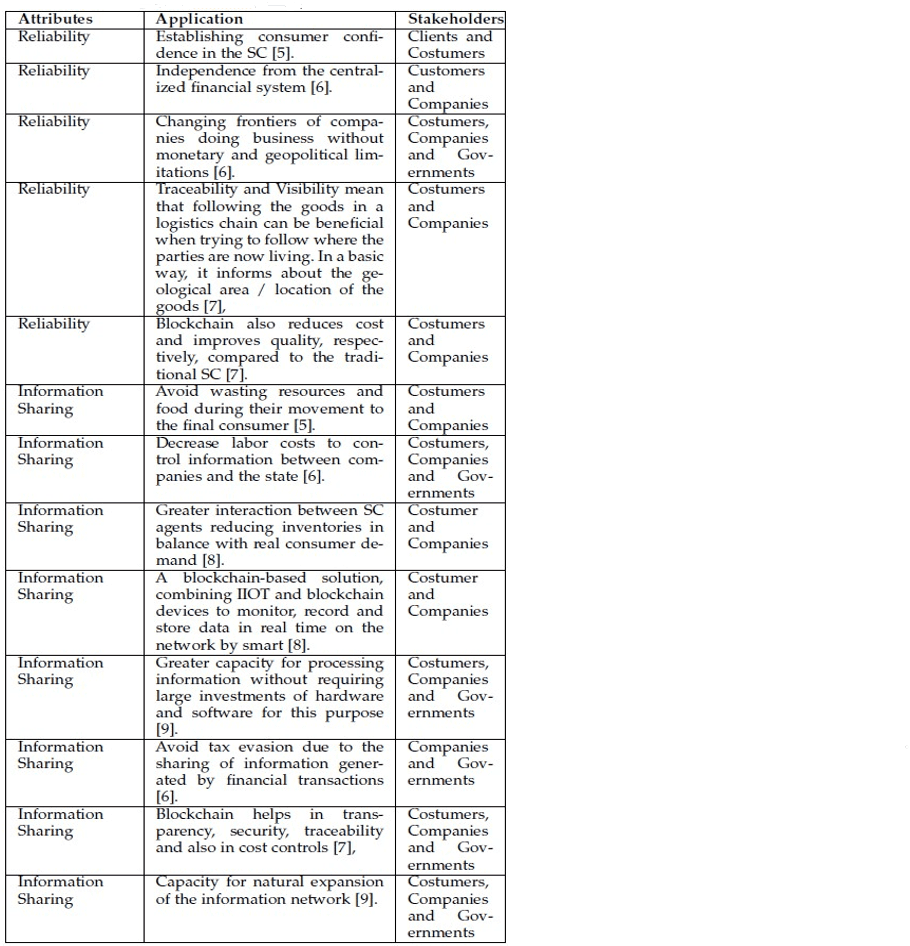
The attributes toward the use of blockchain technology are in Figure 5. Such attributes show how blockchain technology can help the transaction information in a SC.
In order to make better use of the content explored in the chosen databases, the research was oriented to carry out a systematic review of the acquired literature according to the definition of the search string. The research methodology of this article was carried out according to the following steps:
1) Data selection and analysis.
2) Selection of relevant information.
3) Literature review.
-
- Phase 1 – Search the database using the string;
- Phase 2 – Delete duplicate articles;
- Phase 3 – Check the title and abstract using the inclusion and exclusion criteria;
- Phase 4 – Reading and analyzing the articles. Classification of articles according to the inclusion and exclusion criteria;
The databases previously chosen as a starting point for the research were the IEEE Xplore, ACM, Science Direct and Springer platforms.
4.1 PROCESS OF RESEARCH
The definition of the research process can be made clearer by means of well-defined research steps and having the appropriate protocol for exploring and classifying the information obtained in the explored database. For this purpose, the processes pursued by our systematic review were shown in Figure 6.
4.2 DATA SELECTION AND ANALYSIS
The selection of the publication date departed from the year 2017 until the year 2020, when blockchain technology showed a large growth in the number of publications, Figure 7.
The database search was not considered to be papers from conferences, book chapters and others, only papers from periodical journals were taken into account.
By reading the abstracts of the papers extracted from the bases, there was also the classification of this by area of application of the researched technology.
The research was developed through the application of the research strings described in the following Table 3.
Table 1 – Number of papers found per database
| Research string | Database | Number of papers |
| blockchain and logistic and hyperledger, blockchain and logistic and sawtooth, blockchain and SC and hyperledger, blockchain and SC and sawtooth | ACM
IEEE ScienceDirect Springer Total |
46
5 17 53 121 |
Source: author.
Among the selection criteria of the papers relevant to the study are:
- Papers in English language.
- Papers describing situations relevant to the research objective.
- Papers in which the use of blockchain technology is the solution of choice for sharing logistics and SC information.
- Papers aimed at reviewing the literature that deal with the use of blockchain technology in the movement of materials and interaction between companies.
For the exclusion criteria of papers irrelevant to the study in question are:
- Papers that use blockchain technology in the financial or governmental area.
- Papers in which the use of IOT with blockchain technology does not consider the logistics and SC area applied.
- Papers that use blockchain technology as a database solution
4.3 SELECTION AND CLASSIFICATION OF RELEVANT INFORMATION
To carry out the qualification of the papers within the inclusion and exclusion criteria, two qualification steps for these papers were developed and from these steps to generate their relevance classification.
- Step 1
1)The study cite solutions about the Hyperledger Sawtooth platform?
2) The study use the blockchain technology for logistic and SC area?
3) Do they answer our research questions?
4) Does the study include any innovative research on blockchain?
5) Does the article have examples similar to my research?
- Step 2
1) The paper has a clear objective?
2) Does the study compare the results obtained with the results of other studies?
3) In the paper are there answers about RQ1?
4) In the paper are there answers about RQ2?
5) In the paper are there answers about RQ3?
For the evaluated paper to go through step 1 of evaluation, it is necessary to have a positive answer to at least 2 questions in this step, not obtaining this number of positive answers, the article can be classified according to the items below.
- Classification 0 – no positive answer to the questions asked in step 1
- Classification 1 – 1 positive answer to the questions asked in step 1
- Classification 2 – 2 positive answers to the questions asked in Step 1 (able to move on to the next qualification step)
Moving to Step 2 of paper qualification, the number of positive responses delimits the paper’s relevance rating for the proposed systematic review work.
- Classification 2 – 2 positive answers to the questions asked in Step 2
- Classification 3 – 3 positive answers to the questions asked in Step 2
- Classification 4 – 4 positive answers to the questions asked in Step 2
- Classification 5 – 5 positive answers to the questions asked in Step 2
Among the 121 papers found in the databases, 36 papers were classified in Step 1 to participate in the qualification process of Step 2, such papers obtained a score of relevance greater than 1. In Step 2, the papers were rigorously analyzed, following the criteria described above, in order to obtain and classify the items of answers to the research questions in this paper. See Figure 8, which represents the percentage of papers qualified for Step2. After applying the proposed research methodology, the results obtained from such research in the chosen databases are described in the next section.
Figure 9 shows the list of papers approved for Step 2 and the papers were analyzed in detail.
5. RESULTS AND ANALYSIS
This section describes the results achieved with the application of the proposed research methodology and the answers to the research questions.
Figure 6 – Process of research methodology
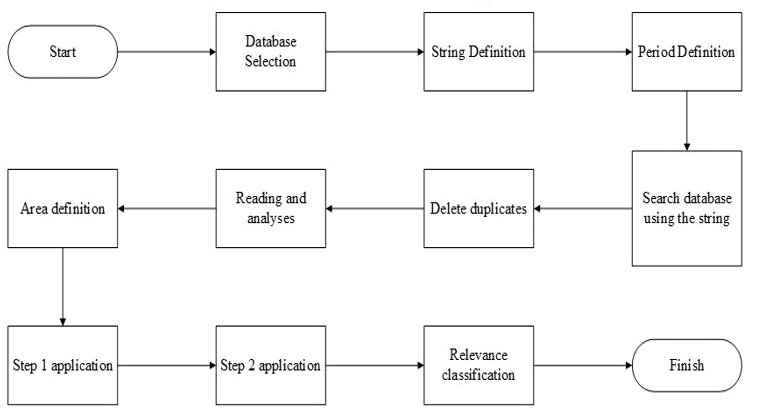
Figure 7 – Number of papers published
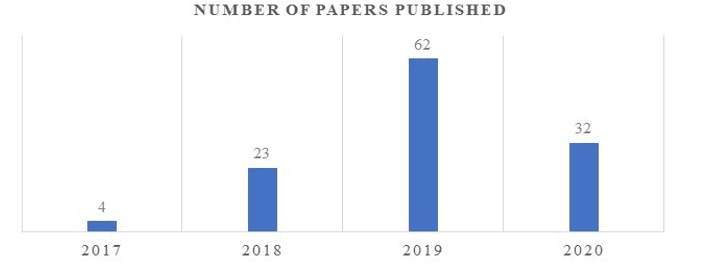
Figure 8 – Papers between research steps
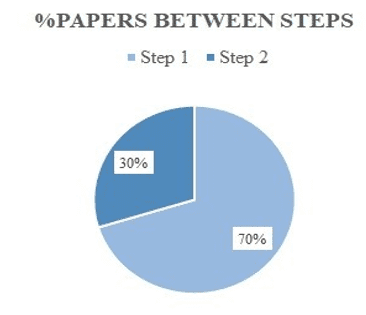
We can see in Figure 10 the classification of relevance of the researched papers and their area of application.
In this graph (Figure 10), most of the papers with greater relevance to the research contained in this paper are in the areas of agriculture and logistics / SC. Since 80 percent of the papers in the agricultural area have a rating of 5 taking into account the qualification performed in Step 2 and 20 percent of the papers in this area with a rating of 2. The papers in the logistics / SC area also have great relevance for the study in question, having 65 percent of the papers evaluated within classification 5, the rest of the papers in this area are classified in categories 1, 2 and 4 with approximately 12 percent each.
The source of data with the largest number of relevant papers for research was Science Direct, followed by ACM, IEEE and Springer respectively. The total number of papers found in the databases surveyed by Springer presented the largest number of papers available, followed by ACM, Science Direct and IEEE, see Figure 11.
5.1 RQ1 – BENEFITS OF BLOCKCHAIN FOR LOGISTIC AND SC
After the analysis carried out in the papers selected in Step 2, in which they answer the research question:
RQ.1 – What are the benefits of blockchain technology for logistic and SC?
The data analysis work was based on the application and realization of the benefits classification in order to link with possible problems that will be solved or mitigated through this.
When we analyze the benefits founded among in papers we can observe that some then give great importance about traceability. Among the 36 papers qualified to Step-2 16 papers presented the benefits of blockchain technology applied in logistic and SC area. The distributed ledger features a new storage layout that reduces the redundancy of records made without affecting SC operations (GAO et al., 2018).
Many areas of the economy will be deeply affected by the deployment of blockchain technology, but the SC deserves special attention. The growing trend of using IOT applications that will affect SCM and with the use of technologies such as IOT, radio frequency identification (RFID) tags, sensors, bar codes, GPS tags and chips, product location, packaging and containers for traceability of each stage of the SC, allowing real-time tracking of the item from its point of origin (KSHETRI, 2018).
Lin et al. (2018) shows the importance of traceability in the food SC for the safety of food delivered to consumers. Over the past few years, many solutions for emerging technologies have been proposed to improve the traceability of animals, plants and manufactured products.
Figure 9 – Step 2 papers
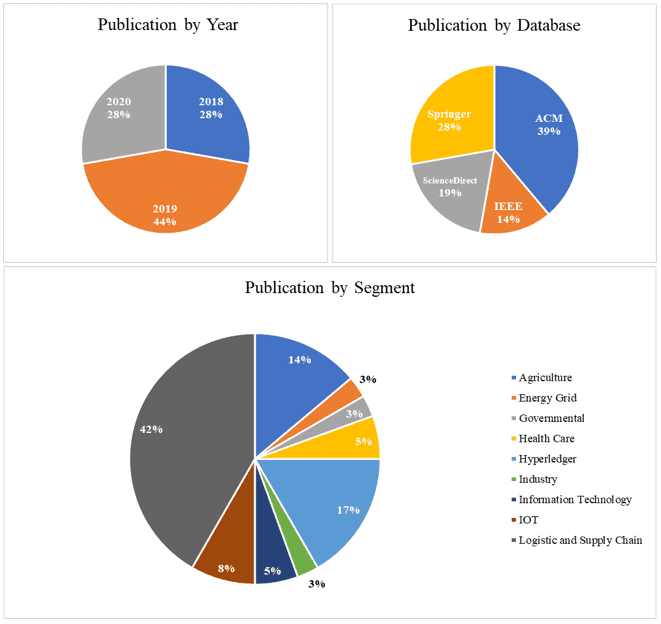
Baralla; Pinna and Corrias (2019), the blockchain solution aims to guarantee data integrity, traceability, saving these data in a single sharing mechanism, thus obtaining transparency of deposits, fulfilling the requirement of reliability for consumers. Proposing a blockchain system to have the traceability of food products to guarantee the origin of such items. In this project they use an Ethereum platform to implement an agricultural product SC using the smart contract mechanism very widely applied to the Ethereum platform. This paper also highlights other studies carried out, in which the use of blockchain technology applied in order to ensure traceability, with a satisfactory SC, may have to guarantee the quality of products outside the established standards. This is possible using blockchain technology in conjunction with other technologies, such as RFID, IOT, digital sensors and AI placed within the physical flow of SC information networks.
Terzi et al. (2019), mentions company like Everledger and Prov Provenience that make use of blockchain technology to create networks of trust through the characteristic of transparency of this technology, creation of permanent records in a digital fiscal book, such a situation proves the provenance and legitimacy of the items thus recognizing any type of forgery employed. Recognizing the counterfeiting employed is already of great importance because of the large SCs spread across the globe integrating several continents, thus making it difficult to trace such items. Another point of influence on the importance of using blockchain technology and the commitment to its benefits are due to the constant scandals involving forced labor and labor abuses such as that of Nike, ASOS, Marks & Spencer and others, cause what customers wake up to importance of the origin of the products purchased and how they are produced. blockchain technology is committed to changing this situation by involving all participants in the SC due to the characteristics it possesses. Due to its immutability characteristic, blockchain technology makes it impossible to delete or change the record made after it is recorded in the book, thus trust between participants in the SC is guaranteed. According to Cui et al. (2019b), the potential for annual risk of counterfeiting in the global SC is 169 billion of dollars and increasing, as the life cycle of critical infrastructure in general is very long compared to the useful life of electronic parts, it is necessary to having spare parts that are often obsolete and are no longer on the production line by their original manufacturers, such items are currently produced by unreliable offshore companies without commitment to the correct manufacturing processes of their products and subject to future operational problems. blockchain technology is able to provide transparency, but also assist in the creation of immutable records, leading to the traceability of inputs (BUMBLAUSKAS et al., 2020) used in the manufacture of products.
Figure 10 – Relevance by area
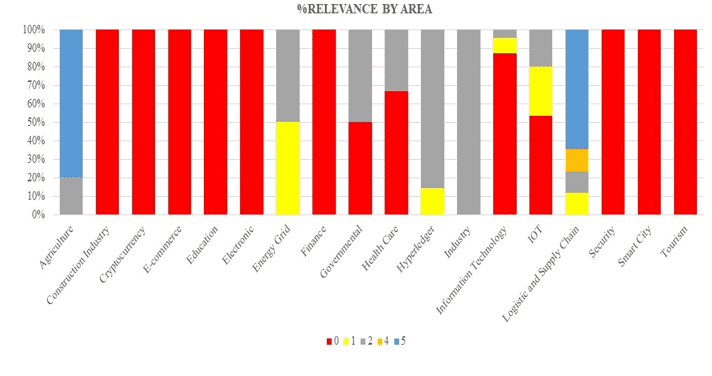
Figure 11 – Relevance papers by database
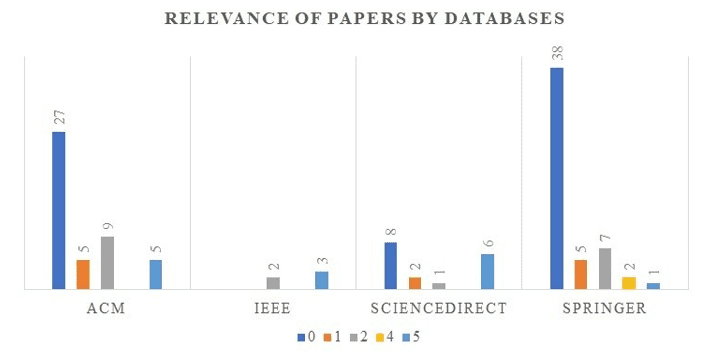
Zhao et al. (2019), explain that in the context of the industrial revolution 4.0 and distributed computing, the characteristics of the information system in the agri-food industry has undergone major changes and blockchain technology has benefits interrelated to its functional characteristics such as the recording of transactions in time real, without the need for intermediaries for its validation, the immutability of the information registered in the network, having its reliability distributed among all participants in the network, this makes blockchain technology the first choice for creating an agrifood value chain for improvement and guarantee information security across the network among SC participants. According to Picchi et al. (2019), the proposed research proposes application development with the motivation for choosing blockchain technology as support mechanisms that facilitate and drive the development of such a product. Aspects of data security and privacy are fundamental, in addition to the management of cryptography keys and users, the author mentions the preference for the use of the blockchain platform must have mechanisms that allow its application in public and private environments, playing aspects of scalability and performance, not least, the technology must allow audits by all members of the network and the consensus rules take into account the principles of equality and fairness allowing for reliability among its members. Among the researched papers that meet the requirements for answers to question RQ.1 37% of the results found refer to the traceability characteristic and 28% refer to the reliability characteristic, see Figure 12.
Figure 12 – Blockchain benefits for logistic and SC
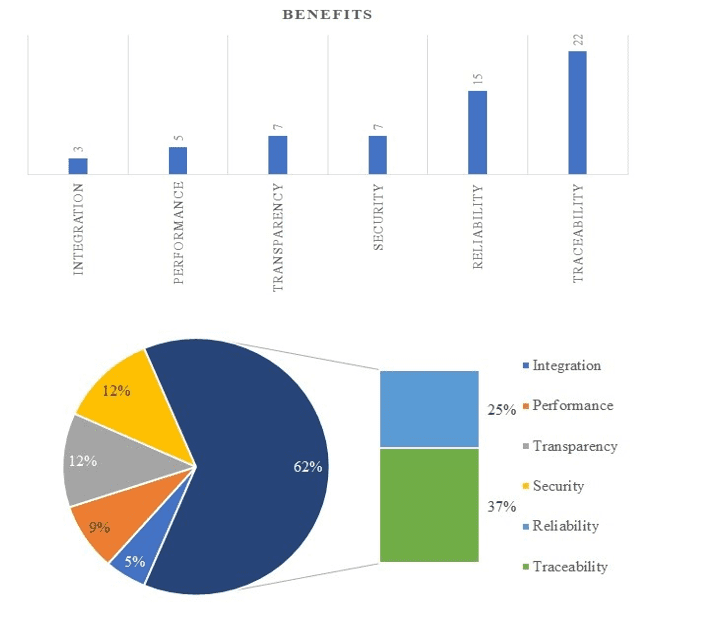
All the benefits found in the area of logistics and SC applied to blockchain technology are related to the problems involved in the movement of materials through companies and their partners. Figure 13 shows us the problems mentioned in the papers researched.
Figure 13 – Problems – RQ1
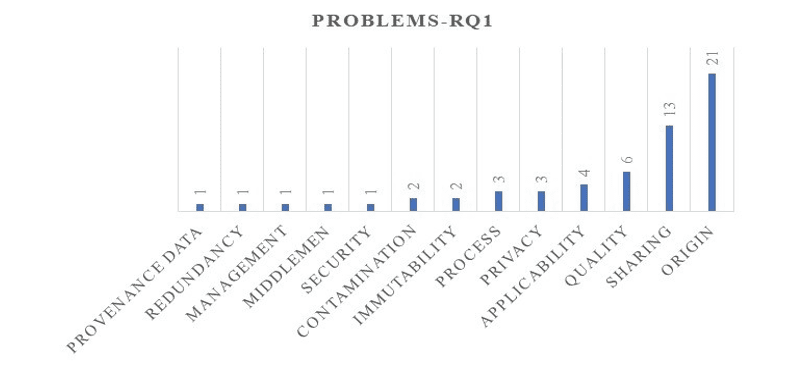
The problems arising from the moved items are the main concern of the studies papers, followed by the sharing of the captured information among the stakeholders of the process, the commitment to maintain the level of quality of the items moved through the SC, applicability of the technology due to high costs and labor qualified for this task, privacy of information shared on the blockchain network, adaptation to the process and current handling and tax guidelines, immutability of information exposing possible process errors, contamination from unsafe and incorrect processes, security of information carried over, use of intermediaries in key processes, management of the information made available on the blockchain network to be shared, redundancy of information that is not on the blockchain network and the source of the information recorded and possible to be used. It was founded 21 relevance mentions about origin problems in the papers researched demonstrating the great concern about this aspects among the authors.
Lin et al. (2018) mentions the common use of chemical fertilizers, pesticides and chemical fertilizers in vegetables, fruits and other vegetables in agricultural crops, such substances present in fruits and vegetables used by their producers to spray these products in order to increase their income. Through the irregular removal of waste water, they can cause contamination of sources of water that are punctual to humans. It can also impair the irrigation of nearby crops, which are often impaired by the pollution of heavier crops such as lead, tin, mercury and zinc which also impairs human health.
5.2 RQ2 – POSITIVE AND NEGATIVE IMPACTS
In this subsection in this paper presents the negative and positive impacts of blockchain technology applications and which are the implications of them.
RQ2 – What are the positive and negative impacts of blockchain technology on traditional logistic and SC?
Figure 14 – % positive and negative impacts
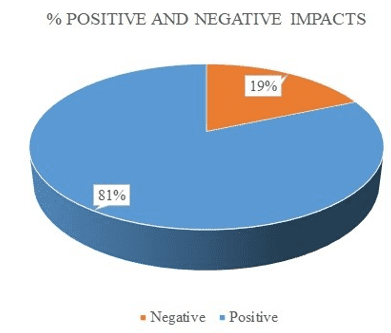
Figure 14 shows among the papers studied that 81% of the impacts considered are rated positively and 19% are considered negative impacts for the implementation of blockchain technology in logistical and SC environments.
Among the classified positive impacts are items such as risk reduction, integration with other technologies, control of contaminated items, visibility of the SC, speed to logistics processes and exchange of information between agents in the SC, security of information exchanged, implementation of regulatory mechanisms for SC control, privacy control of information exchanged according to their respective security layers, immutability of information registered on the blockchain network, financial security among agents inhibiting tax deviations, savings generated by the sharing of resources between SC agents, improved use of available natural resources, improvement of integration mechanisms and generation of active comparison between suppliers and customers. The negative impacts investigated are the costs for implementing the blockchain network and its deficiency between scalability x performance of the applied technology.
Blockchain technology has the potential to be the driving force for demoticing the world economy (PICCHI et al., 2019), in a 2015 report by Cisco and DHL companies estimated that in the next decade, the use of technologies like IOT and blockchain in the SC could generate US $ 1, 9 trillion in value (KSHETRI, 2018) categorizing these as their economic and financial impacts.
Gao et al. (2018). mentions important challenges of blockchain technology for its usability in the SC area: (1) The decentralized ledger generally presents problems involving performance such as limited throughput, long latency for the inclusion of new blocks and inefficient storage for application scenarios that require a high volume of record storage and large numbers of transactions. (2) The information stored in this decentralized ledger is distributed on different nodes. There is a lack of a mechanism to protect information related to the SC stored in the distributed ledger against unauthorized access.
Lin et al. (2018) deals with the use of other technologies in conjunction with other technologies, in which it mentions the proposal for an agricultural product SC traceability system that combines the blockchain solution together with RFID (Radio-Frequency Identification) technology and analyzing its advantages and disadvantages in building a systematic solution demonstrating the process of building this system. Due to the use of this system, traceability can be increased with more reliable information from the entire SC, granting the effectiveness of food safety. Iqbal and Butt (2020). proposes the use of IoT devices with the link to the immutable ledger (blockchain), in which he presents the main question regarding the scalability and efficiency of the proposed solution. This situation guarantees the reliability and sharing of the information captured on these devices among the stakeholders in the SC.
The importance of traceability for the agrifood SC is intended to ensure the safety of the food available to consumers. During the last few years many solutions for this have been implemented but the technology with the most favorable characteristics to meet this demand is blockchain technology (LIN et al., 2018). The use of blockchain technology in the SC is committed to changing the scenario and creating a possibility of tracking the complete journey of a product manufactured by a specific manufacturer and delivered to the customer, creating a lack of trust between us in the SC and visibility of the entire production and distribution process (TERZI et al., 2019). The example presented in Baralla; Pinna and Corrias (2019)., which mentions the cultivation of olives from their origin to their processing, among them the steps are taken to have the item ready for distribution to consumers: first washing of the fruits and storage of raw material, grinding , mixing, extraction and separation, oil storage and final bottling. The information captured during all points of the processes described above are recorded and maintained on the blockchain. Such bottled items are delivered to points of sale to the final consumer, giving this consumer the opportunity to read the QR and have access to the entire production history of the item purchased by him.
The speed of physical processes can be increased through digitization, reducing unnecessary interactions and communications to be performed. Keeping the information on the blockchain network and its transmission can be validated between individuals on the network and assets, minimizing the needs for physical interactions and communication, thus avoiding duplication of information between the agents of the blockchain network (KSHETRI, 2018).
According to Kshetri (2018) the security issue is an important consideration that can separate the blockchain deployment into financial activity and SC. Companies that work with IBM for the implementation of blockchain technology were no less concerned with the information security factor, but there was almost unanimous opposition to the application of a public blockchain system like bitcoin. In the blockchain world there are permissive and non-permissive chains, permissive chains allow the participation of any individual without the need for a pre-analysis of the remaining participants in the blockchain network. Non-permissive chains as developed by IBM verifies the access and compliance of all its participants, due to this security principle it is expected that private blockchain, that is, permissive will have a much faster expansion of use in terms of application compared to bitcoin or other non-permissive platforms of blockchain technology. Auto parts can be stolen or stolen by opponents during transport. Such stolen parts are still valid, however their properties have already been transferred to another member of the blockchain. Another situation is the refusal of the transfer of these items by the recipient of the recipient blockchain. These transactions are carried out on the blockchain in order to create the immutable record of all increased SCM and minimizing executive security risks (CUI et al., 2019b), the example above makes it clear the implementation of a new level of security in the SC with the technology use blockchain. Analyzing the risk control characteristics of the blockchain, its ability to validate identities can be very important to carry out the verification of the origin of items handled and controlled by the blockchain, such as cut diamonds and fine drinks. Only network participants with mutual consent can carry out such transactions, guaranteeing confidentiality, trustworthiness and transparency among participants, reducing risks related to cybersecurity (KSHETRI, 2018).
On the other hand, governments look at blockchain technology in order to ensure greater control of the items obtained and thus not have losses in tax collection, Zhang et al. (2020) mentions the example of the grain industry and its supply supply, in which the use of blockchain technology can control the logistical flow of these items in the SC offering the possibility of having a national emergency regulatory alert system for supplying the population, such research can boost grain SCM due to greater transparency of transactional information. However, in order to create a clear framework for regulating SCs through the implementation of blockchain technology, governments should subsidize investment in infrastructure to implement this technology in SCs (ZHAO et al., 2019).
Zhao et al. (2019), it analyzes three reviews related to blockchain and its possible impact on the economy and society. In these reviews, 16 possible areas were identified from which the blockchain can be applied, including the food security of the population. blockchain technology represents a way to guarantee the transparency and traceability of the agrifood SC, avoiding waste and total usability of the items produced. Regarding the immutability of the information captured and stored in blockchain technology, it is of paramount importance due to the integrity of agricultural environmental data allowing for productive transparency. The lack of adequate and reliable information can delay the production processes due to the uncertainties generated by unreliable information and subject to changes by other members (LIN et al., 2018; WANG et al., 2018). Another good application of blockchain technology that can have a great impact is on the control and location of farms and their respective productive areas, linking their stand-off areas, their animal population and agri-food production (PICCHI et al., 2019).
Figure 15, show us by impact category:
Figure 15 – Impacts of blockchain technology
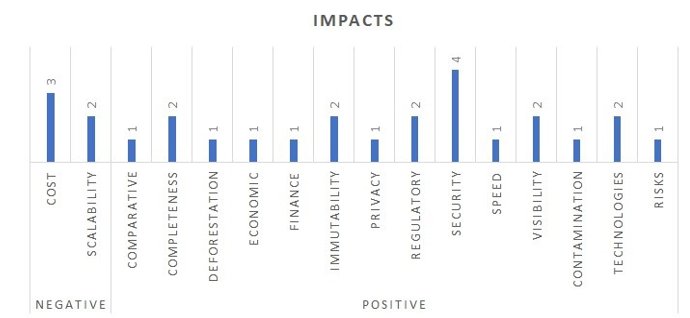
When we talk about the negative impacts of using blockchain technology, nowadays, the issue of scalability that limits the amount of transactions capable of blockchain managing. Perboli; Musso and Rosano (2018) mention that the co-founder of Ethereum coined the term “scalability trilemma” to refer to the great difficulty of combining decentralization, scalability and security for information, in such a passage he confirms that blockchain systems can have maximum two of these three priorities. Following this point, public blockchain, such as Bitcoin and Ethereum, are designed to be decentralized and secure, with no possible scalability, reaching their performance between 7 and 15 transactions per second.
Another negative impact inherent in the use of technology blockchain concerns the economic cost to the generation of a blockchain code, even considering small transactions. costs are considering when we use other technologies such as IOT and RFID to detect, measure and track the processes involving the SC, such costs can be mitigated by the ease of finding a defective product or contaminated using these technologies together with blockchain (KSHETRI, 2018).
5.3 RQ3 – SC SOCIO-ENVIRONMENT SUSTAINABLE
Through the use of blockchain technology assisting and supporting the information of origin, production and distribution of products, thus providing the opportunity for the population to have knowledge of the CS of the item they want to obtain. According to Picchi et al. (2019) with this growing demand there is a need to develop reliable information platforms that can address traceability and socioenvironmental monitoring from the start of production to the final consumer.
Another issue concerns logistics and transport, which by their nature are complicated to have efficient management, but this is very complicated when we try to be efficient in transporting goods in large urban centers, taking into account traffic and its rules depending on each region, congestion during peak hours and fuel consumption resulting from a low effectiveness in the management of these transports and logistics when we consider storage at the correct points for customer service. To overcome this situation, a radical change is required in the current management system and in the availability of the physical internet with the items transported in order to have the information in real time, combining this point with the synchronization of the intermodal services between the currently available means of transport. in urban centers that already have new mobility technologies, but also providing reliable means of communication between these transport agents. Blockchain technology can enable such communication from the global physical internet based on physical, digital and operational inter-connectivity, encapsulated with reliable management interfaces and protocols. The development of systems that support the resolution of these situations by providing management, certification of handling items and their tracking are necessary to ensure compliance with the health of the population and regulation of establishments that are points of direct communication to final consumers, enabling a quick response in cases of recall of contaminated food or out of expiration dates available for sale, in cases where contamination occurs in transport vehicles or conditioning warehouses, it is possible to know and identify possible contaminated batches and remove them from sales points without affecting population health (PERBOLI; MUSSO and ROSANO, 2018).
Kshetri (2018) mentions the analysis of the retailers’ sustainability policies in logistics focusing on socioenvironmental issues such as noise pollution, congestion and carbon emissions, previous research exposes questions regarding the sustainability of the SC, in which the management of their movements conflict with the natural environment and social situations. The resolution of this situation does not only pass through the private sector and must be dealt with jointly with local governments and other spheres. In order to allow the investigation of food products and to assess possible adulteration, authenticity and toxicity of foods and medicines, chemical and biological sensors are implemented at strategic points in the SC. The presence of allergic substances in foods such as milk, soy, eggs, peanuts and others can be easily found with the use of biosensors. Such sensing depends on specific molecular properties of these products such as enzyme antibodies and colorimetric and mass detection of the items. The implementation of other types of sensors capable of monitoring different production parameters such as the greenhouse environment has the ability to measure the levels of carbon dioxide, water, humidity, temperature and light, in which food is produced. Such information is sent to a central server and after its treatment can trigger parameters that control the greenhouse environment using pumps, heaters and fans. All computerized routines from the production site are stored on a central server and the most important information is shared for the next SC on the blockchain (IQBAL and BUTT, 2020).
At the moment when we analyze SCs globally, their processes are also very complex and are continually exposed to uncertainties on how some items consumed on the European continent can be consumed in countries in Asia, Africa or America. Such products have an adequate production process, were transported within international standards and unable to generate any type of contamination to the final consumer. The use of blockchain technology can support the control and verification of these items throughout the global SC process, as well as the risks exposed to goods consumed anywhere in the globe (KSHETRI, 2018).
5.4 RQ4 – TO AUXILIARY THE GENETIC IMPROVEMENT
DNA/RNA analysis is possible due to the selection ’signature’ found in the bovine genome, that is, changes in certain parts of the DNA, in turn, at points called singlesite polymorphisms (SNP) which serve as the basis for the discovery of DNA markers (BOVINE HAPMAP CONSORTIUM et al., 2009).
The analyzes show that the genetic diversity among the taurine breeds, more present in temperate countries, is smaller than that of the zebu breeds, which have the genetic basis of cows in tropical countries, including the Brazilian herd (BOVINE HAPMAP CONSORTIUM et al., 2009). The comparative mapping process between the races and the genome was carried out using the SNP Chip method, in turn, the tool makes it possible to read 50,000 points of variation in the DNA, which results in agility through automation. In addition, the SNP Chip serves to understand the phylogeny of the species, seeking to know which are the phenotypes of commercial interest, such as, for example, the thermo-tolerance of the bovine, the tenderness of the meat, etc. (BOVINE HAPMAP CONSORTIUM et al., 2009).
In addition to the selection of individuals through their genetic characteristics, the present work will also allow us to have the predictability of hereditary diseases present in the herd and previous action in the prevention and management of the herd according to this information captured in the genomic sequence of the animal (BOVINE HAPMAP CONSORTIUM et al., 2009).
The use of blockchain technology is essential to maintain the reliability and security of possible violations of the genetic information obtained from the herd by reading the animal’s genetic sequence. This genetic information will be compiled by our platform and transformed into a digital animal identity and stored on the network blockchain (BOVINE HAPMAP CONSORTIUM et al., 2009).
Biosensor technology is rapidly gaining ground in our society and these devices will be implemented in the dayto-day life of rural properties in the coming years to detect animal diseases, test the quality of products of animal origin, among other applications. The use of DNA/RNA biosensor devices can also perform the reading of important genetic characteristics for herd productivity, previously identify diseases and establish a unique digital identity of this animal based on the genetic sequence of the specimen (VELASCO-GARCIA and MOTTRAM, 2003).
The biosensor device can be described as a compact analysis device, such device has the characteristic of incorporating a sensitive biological or bio-metric element. This device is usually integrated or connected to the translating system of the results captured by the biosensor. Detection is performed by specifically binding the material of interest to be analyzed to the recognition element of the device. This connection between the materials creates a resulting interaction that generates changes in physicochemical properties that are captured and translated by the transducer component (VELASCO-GARCIA and MOTTRAM, 2003).
6. PROSPECTS
The evolution of blockchain technology and smart contracts are able to offer SCM the possibility to manage the complexity of activities, business transactions between the various participants in the supply chain, and in many cases the lack of end-to-end visibility within the SC (TERZI et al., 2019).
The possibility of using blockchain technology with other technologies such as IoT, RFID and machine learning, biosensors still faces challenges such as electricity consumption and hardware resources even now (CUI et al., 2019a). Such technologies from industry 4.0 can substantially increase the use of blockchain technology, however the development of this integration must be very well defined and delimited so that the blockchain network does not suffer negative impacts on its performance. IOT technology can contribute to inventory management more quickly with refined accuracy and efficiency (CUI et al., 2019a).
According to Mirabelli and Solina (2020), another important point is the integration of blockchain technology with relational databases through the data layer of an application, such an initiative allows only important information for product traceability to remain maintained on the blockchain and shared network among the other participants. Secondary but necessary information for the business must be kept in the relational database.
7. CONCLUSION
Among the benefits found, we can highlight the traceability and reliability added to the logistic processes and SCs. These benefits represent 62% of the benefits found among the surveyed items, that is, the two remaining benefits found have important characteristics for SCs such as integration, performance, transparency and information security.
We can conclude that 81% of the impacts found are considered positive in relation to the use of blockchain technology in the areas of logistics and SC, with 19% of the impacts listed negatively for the implementation of blockchain technology due to the severe costs of implementing and scaling the technology in relation to to a large number of data generated in SCs that are global and often interconnected. Make SCs socio-environmentally compatible with the growing demand for the need for food production processes or the use of pesticides and possible forms of contamination along the SC to the point of sale. The complexity of the global SC makes it necessary to rely on mechanisms such as blockchain technology to guarantee production, transport and storage methods.
The integrated use of blockchain technology as biosensors can make a great difference even for the genetic improvement for the production of animal protein, according to the researched sources, of which we can see that 21% of the problems raised are due to the lack of origin of the product.
The perspective of using other 4.0 technologies coupled to the solutions developed on the blockchain is substantially relevant because 13% of the problems found in the systematic review come from the sharing of information between the agents of the blockchain network.
REFERENCES
ABEBE, Ermyas et al. Enabling enterprise blockchain interoperability with trusted data transfer (industry track). In: Proceedings of the 20th International Middleware Conference Industrial Track, p. 29–35, 2019.
ARMSTRONG, Eileen et al. Genetic and productive background of criollo cattle in Argentina, Mexico, Uruguay and the United States. Journal of Arid Environments, v. 200, p. 104722, 2022.
AZZI, Rita; CHAMOUN, Rima Kilany; SOKHN, Maria. The power of a blockchain-based supply chain. Computers & Industrial Engineering, v. 135, p. 582–592, 2019.
BALLOU, Ronald H; SRIVASTAVA, Samir K. Business logistics/ Supply chain management: planning, organizing, and controlling the supply chain. India: Dorling Kindersley, 2007.
BARALLA, Gavina; PINNA, Andrea; CORRIAS, Giacomo. Ensure traceability in european food supply chain by using a blockchain system. In: 2019 IEEE/ACM 2nd International Workshop on Emerging Trends in Software Engineering for Blockchain (WETSEB), p. 40– 47, 2019.
BEHNKE, Kay; JANSSEN, Marijn F. W. H. A. Boundary conditions for traceability in food supply chains using blockchain technology. International Journal of Information Management, v. 52, p. 101969, 2020.
BOSCHI, Alexandre A. et al. An exploration of blockchain technology in supply chain management. In: 22nd Cambridge International Manufacturing Symposium University of Cambridge, 2018.
BOVINE HAPMAP CONSORTIUM et al. Genome-wide survey of SNP variation uncovers the genetic structure of cattle breeds. Science, v. 324, n. 5926, p. 528-532, 2009.
BUMBLAUSKAS, Daniel et al. A blockchain use case in food distribution: do you know where your food has been? International Journal of Information Management, v. 52, p. 102008, 2020.
COMIN, Helena Brocardo et al. Genetic parameters and accuracy of traditional and genomic breeding values for resistance to infectious bovine keratoconjunctivitis in Hereford. Livestock Science, v. 264, p. 105078, 2022.
CUI, Pichen et al. Blockchain in IoT: Current trends, challenges, and future roadmap. Journal of Hardware and Systems Security, v. 3, n. 4, p. 338–364, 2019a.
CUI, Pinchen et al. A blockchain-based framework for supply chain provenance. IEEE Access, v. 7, p. 157113–157125, 2019b.
EMBRAPA. Pastagens. Embrapa, 2015. Disponível em: https://www.embrapa.br/qualidade-da-carne/carne-bovina/producao-de-carne-bovina/pastagem. Acesso em: 28 fev. 2023.
GAO, Zhimin et al. CoC: a unified distributed ledger based supply chain management system. Journal of Computer Science and Technology, v. 33, n. 2, p. 237–248, 2018.
GISLON, G. et al. Bovine beta casein polymorphism and environmental sustainability of cheese production: The case of Grana Padano PDO and mozzarella cheese. Sustenable Production and Consumption, v. 35, p. 85-94, 2023.
HEWETT, Nadia; LEHMACHER, Wolfgang; WANG, Yingli. Inclusive deployment of blockchain for supply chains. Cologny: World Economic Forum, 2019.
INSTITUTO BRASILEIRO DE GEOGRAFIA E ESTATÍSTICA – IBGE. Censo Agropecuário. IBGE, 2017. Available in: https://www.ibge.gov.br/estatisticas/economicas/agricultura-e-pecuaria/21814-2017-censo-agropecuario.html?=&t=resultados. Access at: 01 mar. 2023.
IQBAL, Razi; BUTT, Talal Ashraf. Safe farming as a service of blockchainbased supply chain management for improved transparency. Cluster Computing, v. 23, p. 2139-2150, 2020.
KSHETRI, Nir. 1 Blockchain’s roles in meeting key supply chain management objectives. International Journal of Information Management, v. 39, p. 80–89, 2018.
LIN, Jun et al. Chai. Blockchain and IoT based food traceability for smart agriculture. In: Proceedings of the 3rd International Conference on Crowd Science and Engineering, p. 1–6, 2018.
MARGULIS, Sergio. Causas do desmatamento da Amazônia brasileira. Brasília: Banco Mundial, 2003.
MIRABELLI, Giovanni; SOLINA, Vittorio. Blockchain and agricultural supply chains traceability: research trends and future challenges. Procedia Manufacturing, v. 42, p. 414-421, 2020.
MORAES, Eduardo Henrique Bevitori Kling de et al. Sistemas intensivos de produção de carne bovina com uso de suplementos multiplos. In: II Simpósio Matogrossense de bovinocultura de corte, 2013.
NAKAMOTO, Satoshi. Bitcoin: a peer-to-peer electronic cash system. Decentralized Business Review, p. 21260, 2008.
PERBOLI, Guido; MUSSO, Stefano; ROSANO, Mariangela. Blockchain in logistics and supply chain: a lean approach for designing real-world use cases. IEEE Access, v. 6, p. 62018–62028, 2018.
PICCHI, Vasco V. et al. Increasing the confidence of the brazilian livestock production chain using blockchain. In: Proceedings of the 2019 2nd International Conference on Blockchain Technology and Applications, p. 93-98, 2019.
PIMENTA, Celia Aparecida Marques; LIMA, Jacqueline Miranda de. Genetica aplicada à biotecnologia. São Paulo: Erica, 2015.
REJEB, Abderahman. Halal meat supply chain traceability based on haccp, blockchain and internet of things. Acta Technica Jaurinensis, v. 11, n. 1, 2018.
RIPOLI, María Verónica et al. History and selection imprinting on genetic relationships among bovine breeds analyzed trough five genes related with marbling. Research in Veterinary Science, v. 90, n. 2, p. 245–252, 2011.
ROŽMAN, Nejc et al. Distributed logistics platform based on blockchain and IoT. Procedia CIRP, v. 81, p. 826–831, 2019.
SOK, Kimheng; COLIN, Jean Noël; PO, Kimtho. Blockchain and internet of things opportunities and challenges. In: Proceedings of the Ninth International Symposium on Information and Communication Technology, p. 150–154, 2018.
TERZI, Sofia et al. Transforming the supply-chain management and industry logistics with blockchain smart contracts. In: Proceedings of the 23rd Pan-Hellenic Conference on Informatics, p. 9-14, 2019.
VELASCO-GARCIA, Maria N.; MOTTRAM, Toby. Biosensor technology addressing agricultural problems. Biosystems engineering, v. 84, n. 1, p. 1-12, 2003.
WANG, Ziyuan et al. Distributed ledger technology for document and workflow management in trade and logistics. In: Proceedings of the 27th ACM International Conference on Information and Knowledge Management, p. 1895–1898, 2018.
ZHANG, Xin et al. Blockchain-based safety management system for the grain supply chain. IEEE Access, v. 8, p. 36398–36410, 2020.
ZHAO, Guoqing et al. Blockchain technology in agri-food value chain management: a synthesis of applications, challenges and future research directions. Computers in Industry, v. 109, p. 83–99, 2019.
[1] Master in Technological Innovation at the Federal University of São Paulo, MBA in Logistics and Supply Chain and Bachelor in Automation and Control Engineering. ORCID: 0009-0004-9307-6713. LATTES RESUME: http://lattes.cnpq.br/5121167781532926.
Sent: February, 2023
Approved: February, 2023.














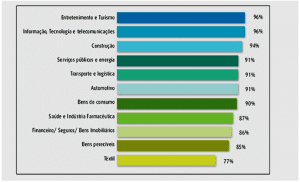
2 Responses
Obrigado pelo excelente conteúdo. Nunca tinha encontrado algo tão completo como esse. Parabéns
Trabalho de excelente elaboração com base sustentável complementados pelos inúmeros exemplos. Em uma globalização que vivemos, sem ferramentas desta natureza se perde muito. A capacidade de ter respostas rápidas faz a diferença em todos os negócios. A importância da rastreabilidade torna os desafios produtivos, capazes de se firmarem em um mundo de constantes mudancas e necessidade de rápidas respostas. Excelente trabalho.